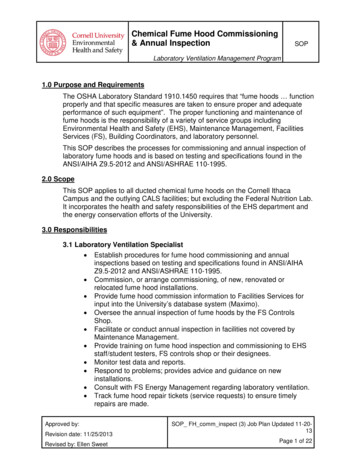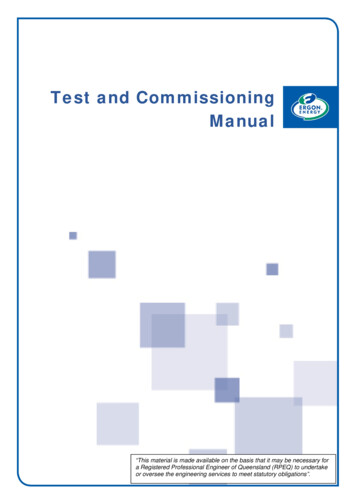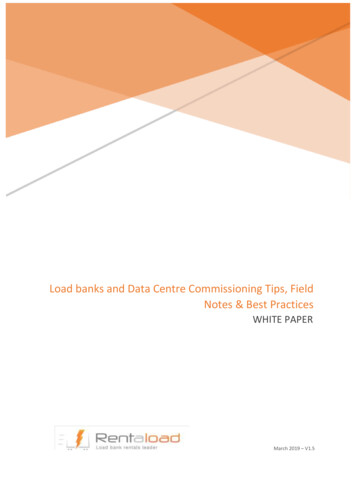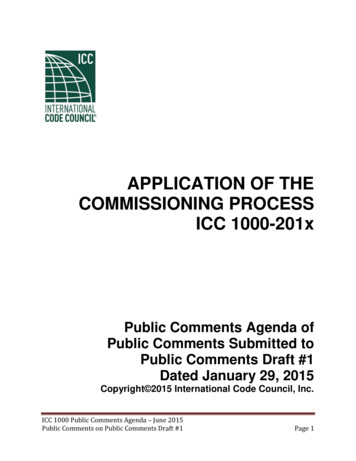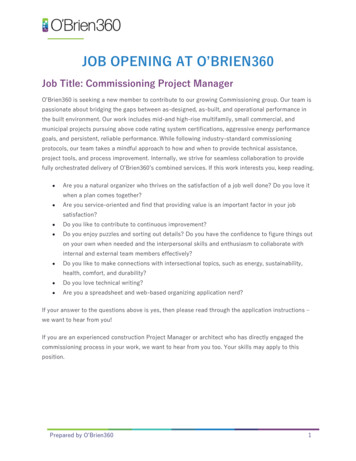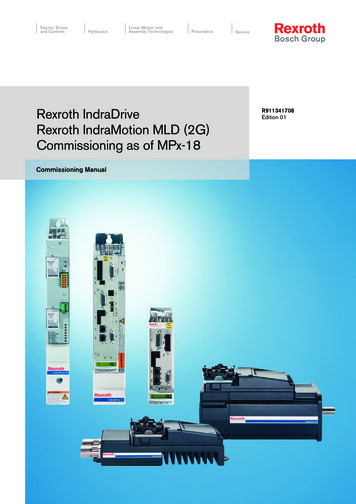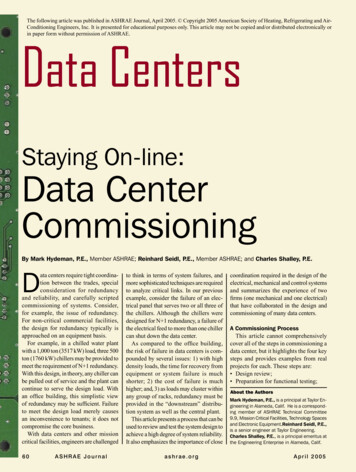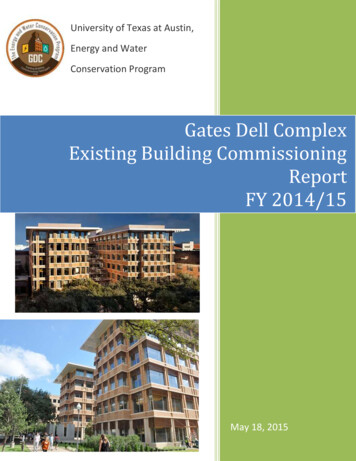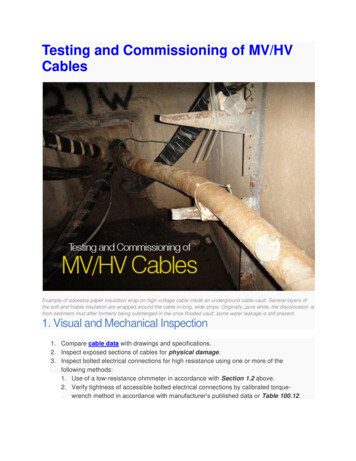
Transcription
Testing and Commissioning of MV/HVCablesExample of asbestos paper insulation wrap on high-voltage cable inside an underground cable vault. Several layers ofthe soft and friable insulation are wrapped around the cable in long, wide strips. Originally, pure white, the discoloration isfrom sediment mud after formerly being submerged in the once flooded vault; some water leakage is still present.1. Visual and Mechanical Inspection1. Compare cable data with drawings and specifications.2. Inspect exposed sections of cables for physical damage.3. Inspect bolted electrical connections for high resistance using one or more of thefollowing methods:1. Use of a low-resistance ohmmeter in accordance with Section 1.2 above.2. Verify tightness of accessible bolted electrical connections by calibrated torquewrench method in accordance with manufacturer’s published data or Table 100.12.
3. Perform a thermographic survey.(NOTE: Remove all necessary covers prior to thermographic inspection. Useappropriate caution, safety devices, and personal protective equipment.)4. Inspect compression-applied connectors for correct cable match and indentation.5. Inspect shield grounding, cablesupports, and terminations.6. Verify that visible cable bends meet or exceed ICEA and manufacturer’s minimumpublished bending radius.7. Inspect fireproofing in common cable areas. (**)8. If cables are terminated through window-type current transformers, inspect to verify thatneutral and ground conductors are correctly placed and that shields are correctlyterminated for operation of protective devices.9. Inspect for correct identification and arrangements.10. Inspect cable jacket and insulation condition.** Optional test2. Electrical Tests1. Perform resistance measurements through bolted connections with a low-resistanceohmmeter, if applicable, in accordance with Section 1.1.2. Perform an insulation-resistance test individually on each conductor with all otherconductors and shields grounded. Apply voltage in accordance with manufacturer’spublished data. In the absence of manufacturer’s published data, use Table 100.1.3. Perform a shield-continuity test on each power cable.4. In accordance with ICEA, IEC, IEEE and other power cable consensus standards, testingcan be performed by means of direct current, power frequency alternating current, or verylow frequency alternating current. These sources may be used to performinsulationwithstand tests, and baseline diagnostic tests suchas partial discharge analysis, andpower factor or dissipation factor. The selection shall be made after an evaluation of theavailable test methods and a review of the installed cable system.Some ofthe available test methods are listed below:.1. Dielectric Withstand:1. Direct current (DC) dielectric withstand voltage2. Very low frequency (VLF) dielectric withstand voltage3. Power frequency (50/60 Hz) dielectric withstand voltage2. Baseline Diagnostic Tests:1. Power factor/ dissipation factor (tan delta):1. Power frequency (50/60 Hz)2. Very low frequency (VLF)2. DC insulation resistance:3. Off-line partial discharge:
1. Power frequency (50/60 Hz)2. Very low frequency (VLF)3. Test Values3.1 Test Values – Visual and Mechanical1. Compare bolted connection resistance values to values of similar connections.Investigate values which deviate from those of similar bolted connections by more than 50percent of the lowest value.2. Bolt-torque levels should be in accordance with manufacturer’s published data. In theabsence of manufacturer’s published data, use Table 100.12.3. Results of the thermographic survey.(NOTE: Remove all necessary covers prior to thermographic inspection. Use appropriatecaution, safety devices, and personal protective equipment.)4. The minimum bend radius to which insulated cables may be bent for permanent trainingshall be in accordance with Table 100.22.3.2 Test Values – Electrical1. Compare bolted connection resistance values to values of similar connections.Investigate values which deviate from those of similar bolted connections by more than 50percent of the lowest value.2. Insulation-resistance values shall be in accordance with manufacturer’s published data. Inthe absence of manufacturer’s published data, use Table 100.1.Values of insulationresistance less than this table or manufacturer’s recommendations should be investigated.3. Shielding shall exhibit continuity. Investigate resistance values in excess of ten ohms per1000 feet of cable.4. If no evidence of distress or insulation failure is observed by the end of the total time ofvoltage application during the dielectric withstand test, the test specimen is considered tohave passed the test.5. Based on the test methodology chosen, refer to applicable standards or manufacturer’sliterature for acceptable values.
TablesTable 100.12.1Bolt-Torque Values for Electrical Connections- US Standard Fasteners (a)- Heat-Treated Steel – Cadmium or Zinc Plated (b)Table 100.12.1 - Bolt-Torque Values for Electrical Connectionsa) Consult manufacturer for equipment supplied with metric fasteners.b) Table is based on national coarse thread pitch.Table 100.12.2- US Standard Fasteners (a)- Silicon Bronze Fasteners (b, c)
Torque (Pound-Feet)Torque (Pound-Feet)a) Consult manufacturer for equipment supplied with metric fasteners.b) Table is based on national coarse thread pitch.c) This table is based on bronze alloy bolts having a minimum tensile strength of 70,000 poundsper square inch.Table 100.12.3- US Standard Fasteners (a)- Aluminum Alloy Fasteners (b, c)Torque (Pound-Feet)Torque (Pound-Feet) - Aluminum Alloy Fastenersa) Consult manufacturer for equipment supplied with metric fasteners.b) Table is based on national coarse thread pitch.c) This table is based on aluminum alloy bolts having a minimum tensile strength of 55,000 poundspersquare inch.
Table 100.12.4- US Standard Fasteners (a)- Stainless Steel Fasteners (b, c)Torque (Pound-Feet)Torque (Pound-Feet) - Stainless Steel Fastenersa) Consult manufacturer for equipment supplied with metric fasteners.b) Table is based on national coarse thread pitch.c) This table is to be used for the following hardware types: Bolts, cap screws, nuts, flat washers, locknuts (18-8 alloy) Belleville washers (302 alloy).Tables in 100.12 are compiled from Penn-Union Catalogue and Square D Company, AndersonProducts Division, General Catalog: Class 3910 Distribution Technical Data, Class 3930Reference Data Substation Connector Products.
Table 100.1Insulation Resistance Test Values Electrical Apparatus and SystemsTable 100.1 - Insulation Resistance Test Values Electrical Apparatus and SystemsIn the absence of consensus standards dealing with insulation-resistance tests, the StandardsReview Council suggests the above representative values. Test results are dependent on thetemperature of the insulating material and the humidity of the surrounding environment at the timeof the test.Insulation-resistance test data may be used to establish a trending pattern. Deviations from thebaseline information permit evaluation of the insulation.Table 100.22Minimum Radii for Power CableSingle and Multiple Conductor Cables with Interlocked Armor, Smooth or Corrugated AluminumSheath or Lead Sheath
Table 100.22 - Minimum Radii for Power CableANSI/ICEA S-93-639/NEMA WC 74-2000, 5-46 kV Shielded Power Cable for Use in theTransmission and Distribution of Electric Energy, Appendix I – Recommended Bending Radii forCables and Table I1 – Minimum Radii for Power Cable.a. 12 x individual shielded conductor diameter, or 7 x overall cable diameter, whichever is greater.Resource: STANDARD FOR ACCEPTANCE TESTING SPECIFICATIONS for Electrical PowerEquipment and Systems (NETA om/testing-and-commissioning-of-mvhv-cables
available test methods and a review of the installed cable system. . Some ofthe available test methods are listed below: . 1. Dielectric Withstand: 1. Direct current (DC) dielectric withstand voltage 2. Very low frequency (VLF) dielectric withstand voltage 3. Power frequency (50/60 Hz) dielectric withstand voltage 2. Baseline Diagnostic Tests: 1.


